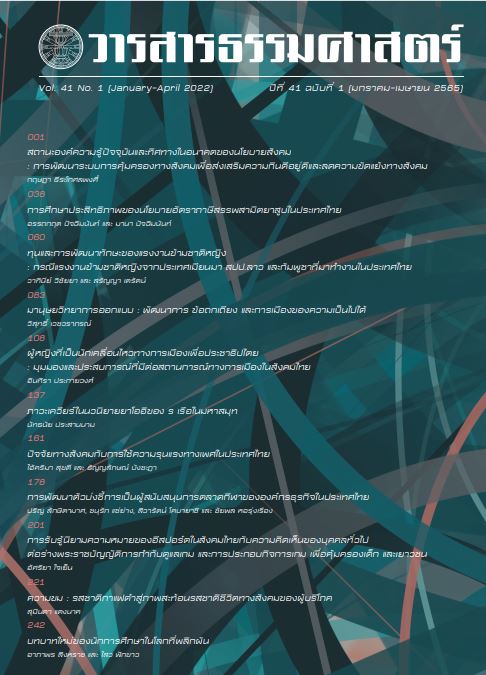Design Anthropology: Development, Debates, and Politics of Possibility
Main Article Content
Abstract
On the idea proposed that design is a fundamental human capacity as well as a primary source of social order, this article explores the development in design anthropology, reviewing concepts, theories, and ethnographic works. It points out that although design anthropology is a historically recent discipline, its impact extends to many issues. This includes several approaches to design, ways to studying, and some debates. Especially the way that created things designed by humans can become political actors for elites, directing mainstream effects on societies. However, at the same time, common people with no design expertise also make attempts to design as their alternative practices, directing their society mutually in their own way as well.
Article Details
References
Appadurai, A. (2013). The Future as Cultural Fact: Essays on the Global Condition. New York: Verso.
Cross, N. (2006). Designerly Ways of Knowing. London: Springer.
Drazin, A., & Garvey, P. (2009).Design and the Having of Designs in Ireland. Anthropology in Action, 16(1), 4-17.
Escobar, A. (1994). Encountering Development: The Making and Unmaking of the Third World. New York: Princeton University Press.
Escobar, A. (2017). Designs for the Pluriverse: Radical Interdependence, Autonomy, and the Making of Worlds. Durham: Duke University Press.
Escobar, A. (2018). “Stirring the Anthropological Imagination: Ontological Design in Spaces of Transition”. In Design Anthropology: Object Cultures in Transition, edited by Alison J. Clarke. 201-216. London: Bloomsbury
Ewart, I. J. (2018). “Designing by Doing: Building Bridges in the Highlands of Borneo”. In Design Anthropology: Theory and Practice, edited by Wendy Gunn et al. 85-99. London: Bloomsbury.
Fry, T. (2012). Becoming Human by Design. London: Bloomsbury.
Gell, A. (1998). Art and Agency: An Anthropological Theory. New York: Oxford University Press.
Gunn, W., & Clausen, C. (2018). “Conceptions of Innovation and Practice: Designing Indoor Climate”. In Design Anthropology: Theory and Practice, edited by Wendy Gunn et al. 159-179. London: Bloomsbury.
Hall, S. (2012). City, Street and Citizen: The Measure of the Ordinary. New York: Routledge
Halse, J., & Boffi, L. (2016).Design Interventions as a Form of Inquiry. In Design Anthropological Futures, edited by Rachel Charlotte Smith et al. 89-103. London: Bloomsbury.
Halse, J,. & Smith, R. C. et al. (2016). Introduction: Design Anthropological Futures. In Design Anthropological Futures, edited by Rachel Charlotte Smith et al. 1-16. London: Bloomsbury.
Halse, J. (2018). Ethnographies of the Possible. In Design Anthropology: Theory and Practice, edited by Wendy Gunn et al. 180-196. London: Bloomsbury.
Ingold, T., & Gatt, C. (2018). From Description to Correspondence: Anthropology in Real Time. In Design Anthropology: Theory and Practice, edited by Wendy Gunn et al. 139-158. London: Bloomsbury.
Ingold, T. (2013). Making: Anthropology, Archaeology, and Architecture. Oxon: Routledge.
Latour, B. (2008). A Cautious Prometheus? A Few Step Forward a Philosophy of Design. Keynote lecture presented at the Networks of Design meeting of the Design Historical Society, Falmouth, Cornwall, United Kingdom, September 2008.
Maze, R. (2016). Design and the Future: Temporal Politics of Making Different. In Design Anthropological Futures, edited by Rachel Charlotte Smith et al. 37-54. London: Bloomsbury.
Miller, D. (2005). Materiality. Durham: Duke University press.
Moon, C. H. (2009). From Factories to Fashion: An Intern’s Experience of New York as a Global Fashion Capital. In The Fabric of Culture: Fashion, Identity, and Globalization, edited by Eugenia Paulicelli. 194-210. New York: Routledge.
Murphy, K. M. (2015). Swedish Design: An Ethnography. New York: Cornell University Press.
Murphy, K. M. (2016). Design and Anthropology. Annual Review of Anthropology, 45(1), 433-449.
Otto, T., & Smith, R. C. (2018). Design Anthropology: A Distinct Style of Knowledge. In Design Anthropology: Theory and Practice, edited by Wendy Gunn et al. 1-29. London: Bloomsbury.
Rabinow, P. et al. (2008). Design for an Anthropology of Contemporary. Durham: Duke University Press.
Schull, N. D. 2012). Addiction by Design: Machine Gambling in Las Vagas. New Jersey: Princeton University Press.
Shea, A. (2012). Designing for the Social Change: Strategies for Community-Based Graphic Design. New York: Princeton Architectural Press.
Smith, R. C., & Kjaergaard, M. G. 2015). Design Anthropology in Participatory Design. In Interaction Design and Architecture(s) Journal, 26(1), 73-80.
Smith, R. C. (2018). Designing Heritage for a Digital Culture. In Design Anthropology: Theory and Practice, edited by Wendy Gunn et al. 117-135. London: Bloomsbury.
Suchman, L. (2011). Anthropological Relocations and the Limits of Design. The Annual Review of Anthropology, 40(1), 1-18.
Suri, J. F. (2005). Thoughtless Acts?. San Francisco: Chronicle Books.
Tsing, A. L. (2015). The Mushroom at the End of the World. New Jersey: Princeton University Press.
Winner, L. (1980). Do Artifact Have Politics. Daedalus, 109(1), 121-136.

